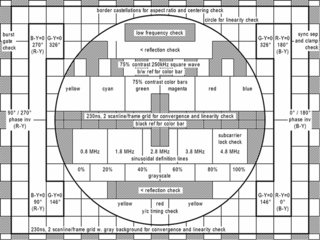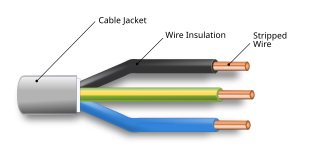In telecommunications, orthogonal frequency-division multiplexing (OFDM) is a method of encoding digital data on multiple carrier frequencies. OFDM has developed into a popular scheme for wideband digital communication, used in applications such as digital television and audio broadcasting, DSL internet access, wireless networks, power line networks, and 4G mobile communications.

Pulse-amplitude modulation (PAM), is a form of signal modulation where the message information is encoded in the amplitude of a series of signal pulses. It is an analog pulse modulation scheme in which the amplitudes of a train of carrier pulses are varied according to the sample value of the message signal. Demodulation is performed by detecting the amplitude level of the carrier at every single period.
Very-high-bit-rate digital subscriber line (VDSL) and very-high-bit-rate digital subscriber line 2 (VDSL2) are digital subscriber line (DSL) technologies providing data transmission faster than asymmetric digital subscriber line (ADSL).

Multichannel Multipoint Distribution Service (MMDS), formerly known as Broadband Radio Service (BRS) and also known as Wireless Cable, is a wireless telecommunications technology, used for general-purpose broadband networking or, more commonly, as an alternative method of cable television programming reception.
DVB-T is an abbreviation for "Digital Video Broadcasting — Terrestrial"; it is the DVB European-based consortium standard for the broadcast transmission of digital terrestrial television that was first published in 1997 and first broadcast in the UK in 1998. This system transmits compressed digital audio, digital video and other data in an MPEG transport stream, using coded orthogonal frequency-division multiplexing modulation. It is also the format widely used worldwide for Electronic News Gathering for transmission of video and audio from a mobile newsgathering vehicle to a central receive point.
DVB-C stands for "Digital Video Broadcasting - Cable" and it is the DVB European consortium standard for the broadcast transmission of digital television over cable. This system transmits an MPEG-2 or MPEG-4 family digital audio/digital video stream, using a QAM modulation with channel coding. The standard was first published by the ETSI in 1994, and subsequently became the most widely used transmission system for digital cable television in Europe, Asia and South America. It is deployed worldwide in systems ranging from the larger cable television networks (CATV) down to smaller satellite master antenna TV (SMATV) systems.
Advanced Television Systems Committee (ATSC) standards are a set of standards for digital television transmission over terrestrial, cable, and satellite networks. It is largely a replacement for the analog NTSC standard, and like that standard, used mostly in the United States, Mexico and Canada. Other former users of NTSC, like Japan, have not used ATSC during their digital television transition because they adopted their own system called ISDB.
Data Over Cable Service Interface Specification is an international telecommunications standard that permits the addition of high-bandwidth data transfer to an existing cable television (CATV) system. It is employed by many cable television operators to provide Internet access over their existing hybrid fiber-coaxial (HFC) infrastructure. The version numbers are sometimes prefixed with simply "D" instead of "DOCSIS".
Digital cable is the distribution of cable television using digital video compression for distribution. The technology was originally developed by General Instrument before being acquired by Motorola and subsequently acquired by ARRIS Group. Cable companies converted to digital systems during the 2000s, around the time that television signals were converted to the digital HDTV standard, which was not compatible with earlier analog cable systems. In addition to providing higher resolution HD video, digital cable systems provide expanded services such as pay-per-view programming, cable internet access and cable telephone services. Most digital cable signals are encrypted, which reduced the high incidence of cable theft which occurred in analog systems.
Terrestrial television systems are encoding or formatting standards for the transmission and reception of terrestrial television signals. There were three main analogue television systems in use around the world until the late 2010s (expected): NTSC, PAL, and SECAM. Now in digital terrestrial television (DTT), there are four main systems in use around the world: ATSC, DVB, ISDB and DTMB.

Amateur television (ATV) is the transmission of broadcast quality video and audio over the wide range of frequencies of radio waves allocated for radio amateur (Ham) use. ATV is used for non-commercial experimentation, pleasure, and public service events. Ham TV stations were on the air in many cities before commercial television stations came on the air. Various transmission standards are used, these include the broadcast transmission standards of NTSC in North America and Japan, and PAL or SECAM elsewhere, utilizing the full refresh rates of those standards. ATV includes the study of building of such transmitters and receivers, and the study of radio propagation of signals travelling between transmitting and receiving stations.
The Grand Alliance (GA) was a consortium created in 1993 at the behest of the Federal Communications Commission (FCC) to develop the American digital television and HDTV specification, with the aim of pooling the best work from different companies. It consisted of AT&T Corporation, General Instrument Corporation, Massachusetts Institute of Technology, Philips Consumer Electronics, David Sarnoff Research Center, Thomson Consumer Electronics, and Zenith Electronics Corporation. The Grand Alliance DTV system is the basis for the ATSC standard.
Spectral efficiency, spectrum efficiency or bandwidth efficiency refers to the information rate that can be transmitted over a given bandwidth in a specific communication system. It is a measure of how efficiently a limited frequency spectrum is utilized by the physical layer protocol, and sometimes by the media access control.
QAM is a digital television standard using quadrature amplitude modulation. It is the format by which digital cable channels are encoded and transmitted via cable television providers. QAM is used in a variety of communications systems such as Dial-up modems and WiFi. In cable systems, a QAM tuner is linked to the cable in a manner that is equivalent to an ATSC tuner which is required to receive over-the-air (OTA) digital channels broadcast by local television stations when attached to an antenna. Most new HDTV digital televisions support both of these standards. QAM uses the same 6 MHz bandwidth as ATSC, using a standard known as ITU-T Recommendation J.83 Annex B ("J.83b").
HD Lite is the re-transmission of a particular HDTV channel at reduced picture quality compared to the source.
Cable-ready is a designation which indicates that a TV set or other television-receiving device is capable of receiving cable TV without a set-top box.
A multiplex or mux is the popular term used for the grouping of program services that are sub-grouped as interleaved data packets for broadcast over a network or modulated multiplexed medium, which are split out at the receiving end. There are two different types of groupings, which are closely related but not identical.
A Web-to-TV installation provides a way to show web television or other over-the-top content from the Internet, to a television set. Various technologies to do this include Home theater PCs, digital media receivers, and Smart TVs.




